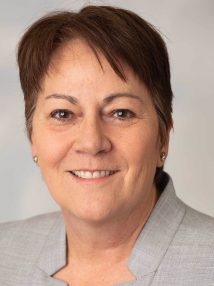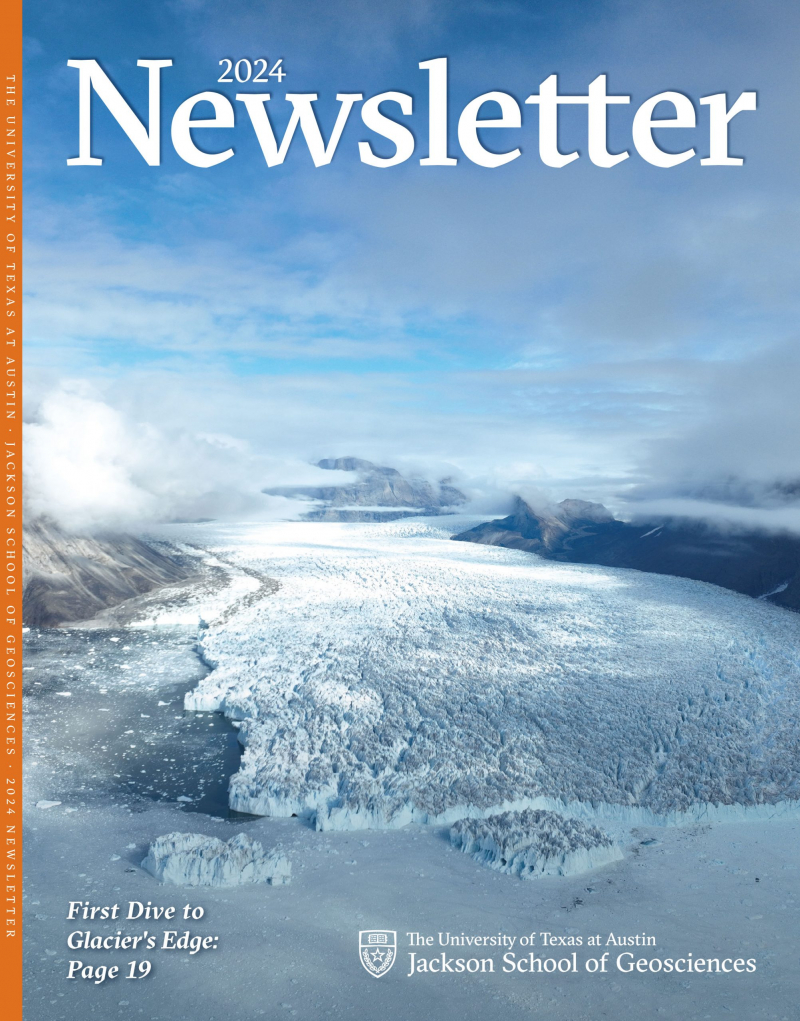2024 Newsletter
Welcome to the Jackson School of Geosciences Newsletter.
A tradition since 1950, the Newsletter highlights research, news and achievements by Jackson School faculty, students, scientists and alumni.
Features
Into the Glacial Abyss
A Jackson School-led mission took a historic dive to Greenland’s glaciers in search of answers to sea level rise.
Geology by Drone
A new drone lab is transforming how field work is done — with researchers now collecting data on geological formations from the air.
New Climate Degree
The story of how the school’s newest major came to be — and how it’s preparing undergraduate students for climate careers.
The Science of Birdsong
Little is known about the form, function and evolution of the syrinx — the unique vocal organ of birds. New research is changing that.
GeoFORCE Turns 20
Now in their 30s, five students from the first GeoFORCE cohort reflect on how the outreach program has shaped their lives and careers.
Star Teacher
How an innovative teacher, an Emmy Award-winning director and a Hollywood celebrity came together to make science cool (or hot.)
Quantifying Chaos
The University of Texas Institute for Geophysics is building global models of Earth’s past to help the insurance industry prepare for the future.
Texas is Energy
What starts here powers the world. The Jackson School is leading the way in energy research at UT.
Briefs
- Jackson School Adds CT Scans to Free Anatomy Archive
- Fingerprinting Forever Chemicals
- Researchers Propose New Step in Tectonic Squeeze
- Little Groundwater Recharge in Ancient Mars Aquifer
- Refining the CO2 Record
- Iron Atoms on the Move in Earth’s Inner Core
- Forecasting Earthquakes With AI
- The Upside to Leaky Pipes: Happy Trees
- Scientists Find Early Warning Sign in Lab-Made Quakes
- Prehistoric ‘Suit of Armor’ Helps Identify New Species of Dinosaur Ancestor
- Earthquakes on the Move in the Midland Basin
- Better Carbon Storage With Stacked Geology
- Water Quality Risks Linked to Social Factors
- UT-City Climate Partnership Thrives
- Research Aims to Keep Water Flowing in the Southwest
- Best Look Yet at Bizarre ‘Worm-Lizard’ Anatomy
- Carbon Storage Survey Update
- How Will Air Pollution Affect Climate Change?
- Lab Experiments Revealing Role of Rock Permeability in Slow Slip Quakes
- ‘Ugly’ Fossil Places Extinct Saber-Tooth Cat on Texas Coast
- Capturing Carbon Across the Country
- Catalysts Could Make Producing Hydrogen From Rocks a Reality
- A New Way to Look Inside the Earth
- Aerial Surveys Reveal Landscape Beneath Antarctic Ice
- Taming Wildfire With Technology
Profiles
Research Experiences
- Surveying Hurricane Beryl’s Impacts on Barrier Islands
- Spring Break in Fairbanks, Alaska
- Surveying the Texas Coast from the Sky
- A Summer in the Arctic Soil
- Hydrology in the Tundra
Outreach
- Texas High School Coastal Monitoring Program Going Strong
- Texas Space Grant Update: Eclipse Science, Designing Moon Tools, Virtual Space Missions
- Eclipse on Campus
- Scientific Meetings
- Field Trip to Jamaica Shows Pathways into the Geosciences
- STARR Sharing Knowledge of Earth Resources Across Texas
Academic Update
- New Curriculum Opens Doors to the Geosciences
- Machine Learning for Geoscientists
- Undergraduate Course Enrollment on the Rise
Summer Field Camps
In the News
Awards & Honors
- 13th Annual Student Symposium Winners
- EER Student Earns Outstanding Student Award From Carbon Storage Summer School
- Sen Named Global Lecturer for AI-Driven Seismic Imaging Course
- Dean Mora Named President-Elect of AGI
- Olariu Awarded Dickinson Medal
- AAPG Honors Flemings With Berg Award
- Milliken Wins Pettijohn Medal
- Banner Named Top Teacher
- Petty Enters Hall of Distinction
- UT Advances in XPRIZE Competition To Fight Fire With UAVs
- Awards List
- Rempe Recognized for Early Career Contributions
- 2024 Faculty Fellows
- Cardenas Named 2025 BDL Lecturer
- Jackson School Students Win Top TA Awards
FANs Board
Alumni Notes
Donors
Geology Foundation Advisory Council
Memorials
Dean's Welcome

The full majesty of geological settings — their wonder, scope and relevance — can sometimes be hard to capture on the cover of the 9-by-12-inch Newsletter. This year’s cover is up to the challenge. It captures the natural majesty of Greenland’s glaciers, the force of their movement across the landscape, and the dynamic interface of glacier, land and sea. Yet, the details of that interface are still poorly understood, hidden in an ungovernable and dynamic environment that makes scientific investigation challenging — even dangerous!
The cover story follows a mission to Greenland led by Professor Ginny Catania to dive to the underwater face of a glacier to take measurements and images never before collected. The science team is trying to fill in one of the major blind spots in ice sheet modeling, a key component in understanding how much seas will rise in the future, both in Greenland and as far away as Texas. Indeed, when she’s not on a research vessel in icy seas, Catania is part of a research group that works with local communities along the Texas Coast, helping them understand how the melting of glaciers half a world away can affect their lives.
At the Jackson School of Geosciences, we are looking beyond the science we do and seeking to connect our work to real people and communities, and to use our science to help resolve the challenges that they face. Tackling the real-world, relevant problems facing society and our planet is what our students aspire to do, and they demand the education to do it. The modern geoscience student is passionate and wants to make the world a better place. Throughout this magazine, you can read stories of how our work is meeting those aspirations. There’s a fascinating story on how our climate modelers are helping the insurance and risk-assessment firm Verisk better understand the risk of a changing world to their business and that of their clients. Another perfect example is the work we are doing with the City of Austin in the UT-City Climate CoLab to help communities right here in Austin become more resilient.
Of course, one of our greatest challenges is to provide all of the energy needed for a modern, healthy and economically sound society. President of The University of Texas at Austin Jay Hartzell has declared 2025 to be the “Year of Energy” on campus, giving us an opportunity to highlight UT’s comprehensive energy research portfolio. In addition to evolving ever more sophisticated science and technology for fossil energy exploration and production, there are new energy sources and systems to develop. There’s an opportunity to move carbon capture and storage to widespread application, a mounting pressure for new mineral and water resources, and new legal, energy economics, and policy scenarios to evolve. Enjoy our story on “The Energy University,” highlighting the ways that the Jackson School is helping spearhead the effort.
I think it’s a testament to the job we are doing as a school of geosciences that our enrollment and credit hours are up, bucking national trends. You can read about the changes we are making to curriculum that are opening the geosciences to more students in our Academic Update section. And, there is a great feature on our new Climate System Science major — the first in the state of Texas. The new program will provide students with a technical and scientific understanding of climate systems that can help them succeed in the careers of the future as businesses, industries and communities work to become more resilient.
I hope you sit down, dive in and enjoy your Newsletter! None of this incredible science or education would be possible without your continued and amazing support! And don’t forget to save the date for the Jackson School’s 20th Anniversary Celebration on April 3-5. It’s going to be an incredible time to reconnect with the school and old friends, dig into a full plate of Texas barbecue, and enjoy some boot scootin’ with Dale Watson & His Lone Stars! I hope to see all y’all there!
Claudia Mora, Dean


